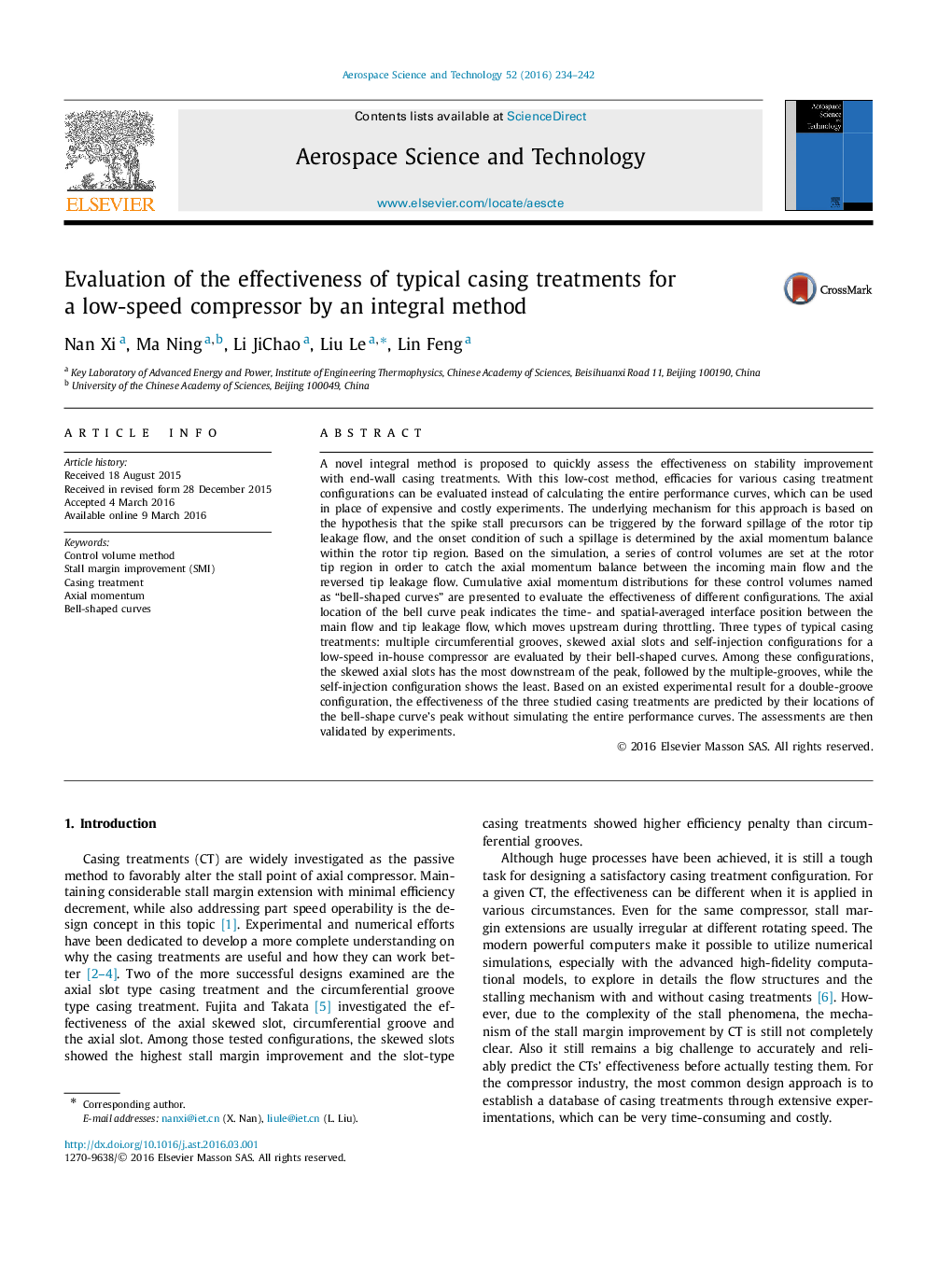| کد مقاله | کد نشریه | سال انتشار | مقاله انگلیسی | نسخه تمام متن |
|---|---|---|---|---|
| 8058661 | 1520082 | 2016 | 9 صفحه PDF | دانلود رایگان |
عنوان انگلیسی مقاله ISI
Evaluation of the effectiveness of typical casing treatments for a low-speed compressor by an integral method
ترجمه فارسی عنوان
ارزیابی اثربخشی درمان های معمول پوشش برای یک کمپرسور کم سرعت با روش یکپارچه
دانلود مقاله + سفارش ترجمه
دانلود مقاله ISI انگلیسی
رایگان برای ایرانیان
ترجمه چکیده
یک روش انتگرال جدید برای به سرعت ارزیابی اثربخشی بهبود پایداری با استفاده از تداخل پوشش دیوار ارائه شده است. با استفاده از این روش کم هزینه، به جای محاسبه تمام منحنی های عملکرد، که می تواند در جای جای آزمایشات گران و پر هزینه استفاده شود، اثربخشی برای تنظیمات مختلف پوشش مصالح می تواند مورد ارزیابی قرار گیرد. مکانیزم زیربنایی این رویکرد بر اساس فرضیه است که پیشروندههای پیشنهادی پیشنهادی سنبله میتوانند از طریق تخلیه پیشرو جریان نشتی روتور ایجاد شود و شرایط شروع چنین انحرافی توسط تعادل حرکت محوری در ناحیه نوک روتور تعیین می شود . بر اساس شبیه سازی، یک سری حجم کنترل در ناحیه نوک روتور تنظیم می شود تا توازن حرکتی محوری بین جریان اصلی ورودی و جریان نشت ناپذیر معکوس بگیرد. توزیع مولد محوری توزیع شده برای این حجم کنترل به نام "منحنی شکل" شکل داده شده است. برای ارزیابی اثربخشی تنظیمات مختلف ارائه شده اند. محل محوری پیک منحنی زنگ نشان می دهد موقعیت رابط بین محدوده زمانی و فضایی بین جریان اصلی و جریان نشت نکته است که در طول ترانزیت حرکت می کند. سه نوع درمان معمولی پوشش: شیارهای چند محوری، شکاف محوری و تنظیمات خود تزریق برای یک کمپرسور خانگی کم سرعت با منحنی های زاویه ای آنها ارزیابی می شود. در میان این تنظیمات، شکاف محوری اسکله پایین ترین قسمت پیک است و پس از چند شیار، در حالی که پیکربندی خود تزریق کمترین را نشان می دهد. بر اساس یک نتیجه آزمایش تجربی موجود برای پیکربندی دو شیار، اثربخشی سه تایی پوشش محوطه مورد بررسی قرار می گیرد، با مکان هایی از پیک منحنی زنگ شکل بدون شبیه سازی تمام منحنی های عملکرد پیش بینی شده است. سپس ارزیابی ها با آزمایش انجام می شود.
موضوعات مرتبط
مهندسی و علوم پایه
سایر رشته های مهندسی
مهندسی هوافضا
چکیده انگلیسی
A novel integral method is proposed to quickly assess the effectiveness on stability improvement with end-wall casing treatments. With this low-cost method, efficacies for various casing treatment configurations can be evaluated instead of calculating the entire performance curves, which can be used in place of expensive and costly experiments. The underlying mechanism for this approach is based on the hypothesis that the spike stall precursors can be triggered by the forward spillage of the rotor tip leakage flow, and the onset condition of such a spillage is determined by the axial momentum balance within the rotor tip region. Based on the simulation, a series of control volumes are set at the rotor tip region in order to catch the axial momentum balance between the incoming main flow and the reversed tip leakage flow. Cumulative axial momentum distributions for these control volumes named as “bell-shaped curves” are presented to evaluate the effectiveness of different configurations. The axial location of the bell curve peak indicates the time- and spatial-averaged interface position between the main flow and tip leakage flow, which moves upstream during throttling. Three types of typical casing treatments: multiple circumferential grooves, skewed axial slots and self-injection configurations for a low-speed in-house compressor are evaluated by their bell-shaped curves. Among these configurations, the skewed axial slots has the most downstream of the peak, followed by the multiple-grooves, while the self-injection configuration shows the least. Based on an existed experimental result for a double-groove configuration, the effectiveness of the three studied casing treatments are predicted by their locations of the bell-shape curve's peak without simulating the entire performance curves. The assessments are then validated by experiments.
ناشر
Database: Elsevier - ScienceDirect (ساینس دایرکت)
Journal: Aerospace Science and Technology - Volume 52, May 2016, Pages 234-242
Journal: Aerospace Science and Technology - Volume 52, May 2016, Pages 234-242
نویسندگان
Nan Xi, Ma Ning, Li JiChao, Liu Le, Lin Feng,
